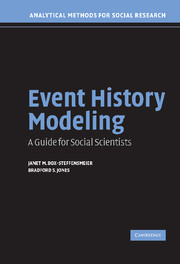Book contents
- Frontmatter
- Contents
- List of Figures
- List of Tables
- Preface
- 1 Event History and Social Science
- 2 The Logic of Event History Analysis
- 3 Parametric Models for Single-Spell Duration Data
- 4 The Cox Proportional Hazards Model
- 5 Models for Discrete Data
- 6 Issues in Model Selection
- 7 Inclusion of Time-Varying Covariates
- 8 Diagnostic Methods for the Event History Model
- 9 Some Modeling Strategies for Unobserved Heterogeneity
- 10 Models for Multiple Events
- 11 The Social Sciences and Event History
- Appendix: Software for Event History Analysis
- References
- Index
9 - Some Modeling Strategies for Unobserved Heterogeneity
Published online by Cambridge University Press: 05 September 2012
- Frontmatter
- Contents
- List of Figures
- List of Tables
- Preface
- 1 Event History and Social Science
- 2 The Logic of Event History Analysis
- 3 Parametric Models for Single-Spell Duration Data
- 4 The Cox Proportional Hazards Model
- 5 Models for Discrete Data
- 6 Issues in Model Selection
- 7 Inclusion of Time-Varying Covariates
- 8 Diagnostic Methods for the Event History Model
- 9 Some Modeling Strategies for Unobserved Heterogeneity
- 10 Models for Multiple Events
- 11 The Social Sciences and Event History
- Appendix: Software for Event History Analysis
- References
- Index
Summary
A variety of problems can emerge in typical event history data sets and concomitant models. One of the most prevalent problems in duration analysis involves the issue of unobserved heterogeneity. In this chapter, we consider the issue of unobserved heterogeneity and modeling strategies that can help gain leverage on the problem. Following this, we return to the issue of censoring and truncation in duration data. This discussion will lead naturally to the consideration of yet another modeling strategy that is appropriate when events, for some subpopulation in a sample, never actually occur (such observations are usually regarded as right-censored). This discussion will lead us to consider the so-called “split-population” model.
Heterogeneity
Heterogeneity can be induced in a model any time relevant covariates are not included in the model's specification. Relevant covariates may be left out because they are unmeasurable, unobservable, or because the analyst may not know that a particular covariate is even important. Heterogeneity can lead to problematic inferences insofar as parameter estimates can be inconsistent, standard errors can be wrong, and estimates of duration dependency can be misleading. Given the problems resulting from heterogeneity, it is important for analysts to think seriously about heterogeneity in developing event history models. Indeed, Manton, Singer, and Woodbury (1992) argue “that model specification must involve considering the likelihood and testing for the presence of unobservable variables to be considered complete” (quoted in Trussel 1992, 2).
- Type
- Chapter
- Information
- Event History ModelingA Guide for Social Scientists, pp. 141 - 154Publisher: Cambridge University PressPrint publication year: 2004
- 1
- Cited by

